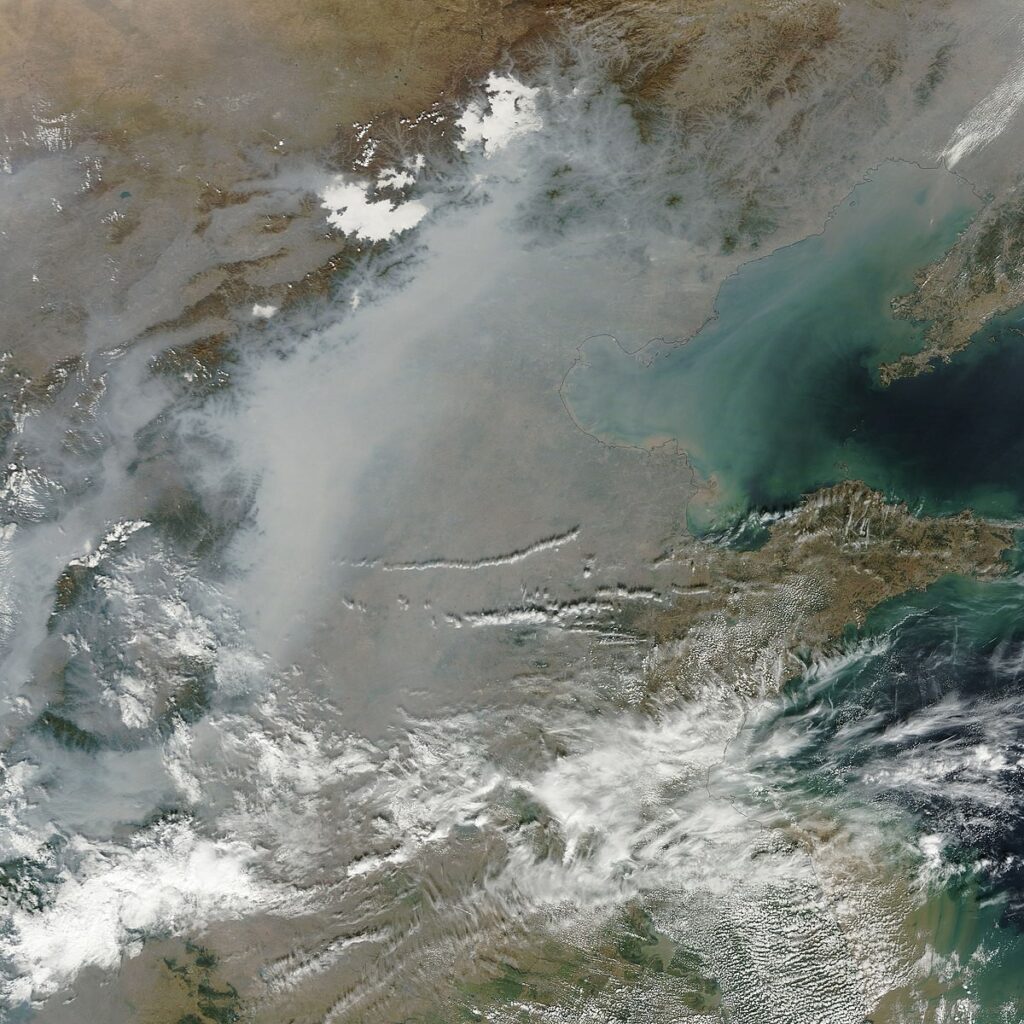
Most of us seldom give thought to things we can’t see — whether literally, as with air particles a tenth as wide as a strand of human hair, or things that simply operate outside of our day-to-day awareness, such as research in the basic sciences. However, a recent study published by a Harvard-China Project postdoc, Shaojie Song, on the chemistry of fine air particles contributing to severe air pollution episodes in China during winter, shows why we should be concerned about things that we cannot perceive.
Tiffany Chan from the Harvard-China Project sat down with Shaojie for a quick lesson on the chemistry of air pollution and a discussion on how the acidity of PM2.5 might influence its effects on human health, as well as how basic sciences underpin the more practical challenge of effective environmental protection.
Shaojie, before we start talking about your recent research on air pollution in China, can you explain what is PM2.5 and why we should care about it? Some of our readers are probably like me and know very little, if anything, about atmospheric chemistry.
Of course. Particulate matter 2.5, PM2.5, is a kind of aerosol — small particles suspended in the air. Other examples of aerosols that are probably more familiar are dust, fog, and smoke. The size of aerosols is usually less than 100 microns [another term for micrometers, or millionths of a meter]. Just to give you an idea: the diameter of a human hair is about 100 microns, so aerosols are smaller than the width of a strand of hair. The 2.5 in PM2.5 refers to the diameter of the aerosol; PM2.5 are aerosol particles that have diameters of less than 2.5 microns, so far smaller than a human hair. Because of their very small size, they can stay in the atmosphere for a much longer period of time than say, dust particles, which are usually larger than 10 microns. Also, because of their small size, PM2.5 can pass through the nose and throat to penetrate deep into our lungs, and enter the cardiovascular system, and therefore have a much more significant impact on human health than larger air particles. In China in the 1980s, the emission of large aerosols was regulated, and then the regulation shifted to aerosols smaller than 10 microns, and now in the 2010s to those smaller than 2.5 microns. This is because people discovered that the negative health effects of PM2.5 are much more significant than those of larger air particles.
By the way, I want to point out a common misperception that people have about PM2.5: when they hear about it in the news, they think that PM2.5 is a pollutant with a specific chemical composition. Actually, PM2.5 refers to an entire class of particles that are smaller than 2.5 microns — it doesn’t refer to their chemistry. PM2.5 can be various chemicals and most often a mixture of them. We atmospheric chemists and physicists often have to determine what the PM2.5 in a given location or episode is actually made up of before investigating what caused it.
Can you tell us about your recent research on smog in China? What did you look at?
As we all know, Beijing and the greater North China Plain have been suffering from severe haze episodes with low visibility and high PM2.5 concentrations, especially during winter. Our recent research tried to answer a specific question: what is the acidity — the pH value — of the PM2.5 that makes up that haze? Because PM2.5 is so very tiny, its pH value is difficult to measure and is usually calculated with so-called thermodynamic equilibrium models. The calculated pH values differed widely in previous studies by our fellow scientists, ranging from close to 0 [highly acidic] to as high as 7 [neutral]. We tried to resolve the large and puzzling differences in the acidity of PM2.5 in Northern China by critically evaluating the models used for calculating it. What we found was that the PM2.5 in the winter haze in Beijing is generally moderately acidic (pH 4 to 5), not highly acidic (pH 0) or neutral (pH 7) as has been sometimes reported. Our work significantly narrows the estimated pH range of PM2.5.

Why should we be concerned about the acidity of PM2.5?
The acidity can actually affect both the formation of PM2.5 and its toxicity. And the toxicity of PM2.5 matters. We know that PM2.5 is bad for human health, but despite lots of research, there are still debates as to what are the exact mechanisms of the health impacts of PM2.5. For example, one theory says that the health impacts are largely due to trace metals. PM2.5, as I mentioned before, is normally a mixture of chemicals — there are organic chemicals, inorganic chemicals like ammonia and nitrate, and trace metals. The acidity of PM2.5 partly determines the amount of soluble trace metals found in these fine particles, since the solubility of trace metals depends on acidity. Low pH [higher acidity] facilitates the attachment of trace metals. Although we are not sure whether the acidity actually affects the health impact of PM2.5 after it is inhaled, trace metals are known to pose a risk to human health. It is important that we understand the chemistry and formation of the PM2.5 that these trace metals are part of in order to calculate their concentration in the air we breathe and then their health effects.
What made you decide to dig into this topic?
When Professor Mario Molina [Nobel Prize-winning chemist] visited Harvard back in February 2017 to give a Harvard-China Project public lecture comparing Beijing and Mexico City air pollution, he met with a group of atmospheric scientists to discuss winter haze. Professor Mike McElroy [faculty chair of the China Project and co-author of this paper], Meng Gao [a China Project postdoc and also a co-author], and I had been puzzling over the calculated acidity of PM2.5 that differed widely in existing literature, and asked Mario during the discussion whether he thought the pH of PM2.5 could be neutral. His short answer was he didn’t know, either. Most scientists at Harvard, including Mike, think that it is chemically impossible — that when you have PM2.5 of neutral acidity, ammonia, which is often a key component of PM2.5, could not stay in the particle phase and would evaporate. So, we decided to dig deeper and find out what the pH of PM2.5 really is in Beijing winter smog.
As someone who studies the basic sciences as opposed to applied sciences, how do you think atmospheric chemistry factors into policy making?
As a researcher in the basic sciences, you can’t say that your research on the chemistry of fine aerosols, for instance, will have a direct policy implication. But I do know that pH is a basic property of aerosol particles, and that understanding pH helps us better understand the formation and toxicity of PM2.5, which might in turn help us better understand the impact of PM2.5 on health. The purpose of the basic sciences is to broaden what we know as humans, and then hopefully, down the line, have indirect impacts on other areas of research and perhaps even policy. Without the knowledge built up bit-by-bit by the basic sciences, though, we will never know what we don’t know — and that has implications on our ability to make effective policies.
Paper cited:
Shaojie Song, Meng Gao, Weiqi Xu, Jingyuan Shao, Guoliang Shi, Shuxiao Wang, Yuxuan Wang, Yele Sun, and Michael McElroy. 2018. “Fine particle pH for Beijing winter haze as inferred from different thermodynamic equilibrium models.” Atmospheric Chemistry and Physics, 18, Pp. 7423–7438.

Shaojie Song is currently a Postdoctoral Fellow at the Harvard-China Project on Energy, Economy and Environment. He received his Ph.D. in Atmospheric Chemistry from the Department of Earth, Atmospheric, and Planetary Sciences at the Massachusetts Institute of Technology (MIT) in 2016. Shaojie’s research is focused on understanding air quality issues in China, particularly the severe winter haze in Beijing.

